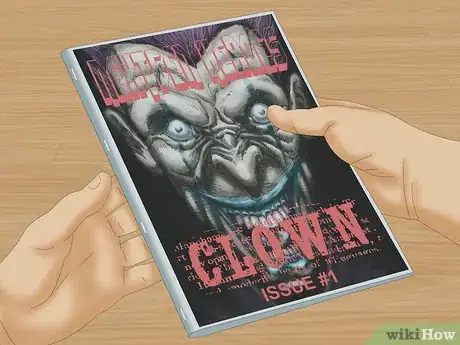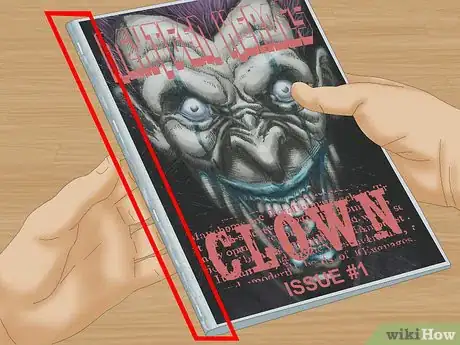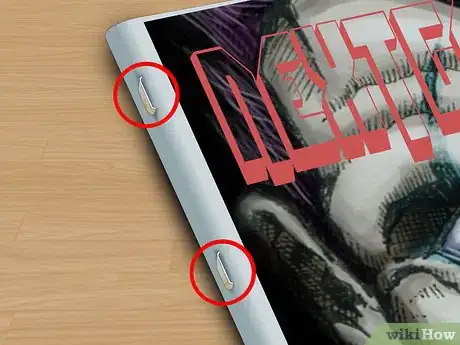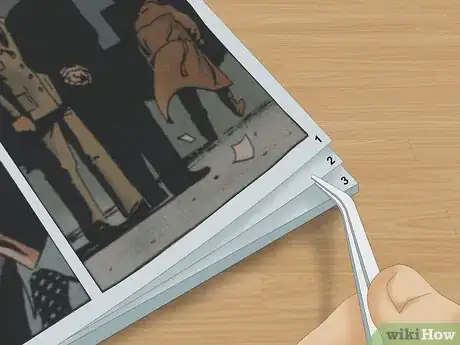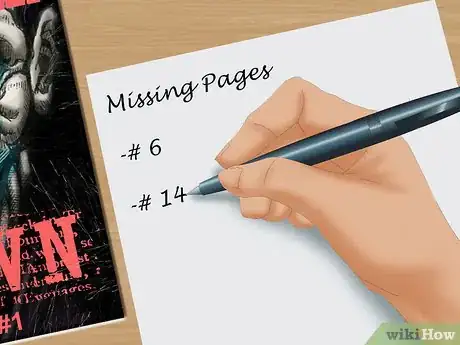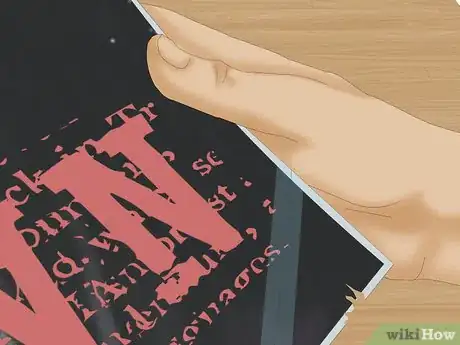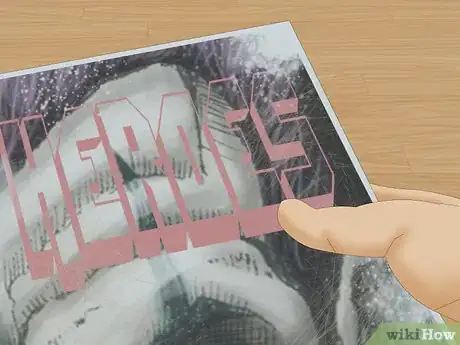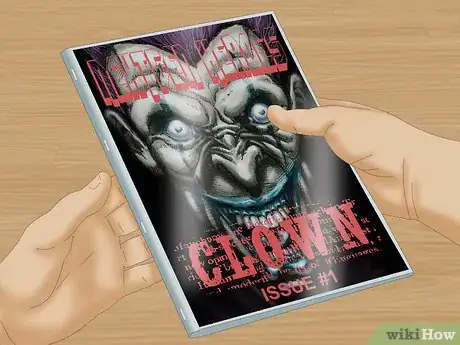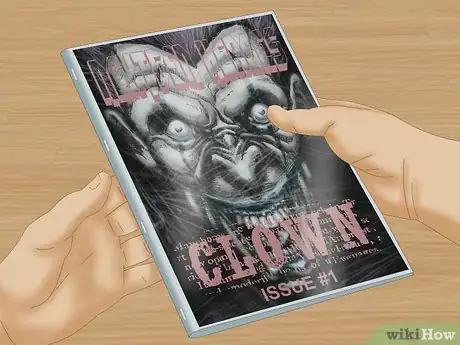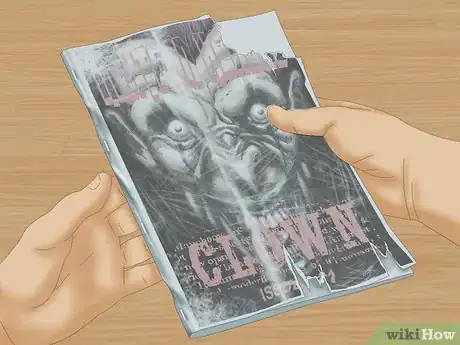This article was co-authored by wikiHow Staff. Our trained team of editors and researchers validate articles for accuracy and comprehensiveness. wikiHow's Content Management Team carefully monitors the work from our editorial staff to ensure that each article is backed by trusted research and meets our high quality standards.
wikiHow marks an article as reader-approved once it receives enough positive feedback. In this case, 97% of readers who voted found the article helpful, earning it our reader-approved status.
This article has been viewed 98,659 times.
Learn more...
The market value of comic books is partly determined by a grading process. This grading process details the exact condition and completeness of a comic, allowing the seller to get an idea of how much it is worth. While there is a certain amount of subjectivity to this process, a reasonably accurate grade can be assigned by a careful amateur.
Steps
Examining the Cover and Spine
-
1Look for cover damage. When grading a comic book, the first thing you'll see is the cover. Take a close look, ideally with a magnifying glass, and make careful notes of any apparent damage, including:[1]
- Bends, folds, or dents that warp the shape or surface of the book, but don't affect the color
- Coackling, a bubbling effect on the cover usually caused by printing defects
- Creases, more severe folds that remove ink or otherwise create distortions in the coloring
- Tears
- Moisture, water damage, or "foxing" (bacterial or fungal growth on the paper)
- Fading, lack of gloss, or "dust shadow" (partial exposure to dust or air resulting in uneven fading)
- Fingerprints, especially those which in which skin oils have led to discoloration of the ink
- Chew (rodent damage)
- Writing or other soiling of the cover.
-
2Make note of attempts to repair the book. Look for evidence of tape or glue or other attempts to repair the book. These generally have a negative effect on the value.[2]
- Note that more sophisticated efforts to restore a comic book, such as color restoration or re-glossing are often undetectable by amateur graders (and sometimes even professionals), but can also have a negative effect on value if noticed by a potential buyer. Such restorations should be noted upfront before attempting to sell a comic book.[3]
Advertisement -
3Examine the spine. Less obvious but equally important to the surface of the cover is the spine of the comic book. Inspect it closely, making note of any of the following:[4]
- Spine stress/bindery tears, small creases, folds, or tears (under 1/4 inch) running perpendicular to the spine
- Spine roll, a curvature of the left edge of a comic toward the front or back, caused by folding back each page of the comic as it was read
- Spine break, spine stress that has become a full tear (usually through multiple pages), typically found near the staples
- Spine split, a clean, even separation at the fold, usually (but not always) right above or below a staple
-
4Inspect the staples. The staples themselves must also be inspected closely. Make sure no staples are missing at that the staples are in good condition.[5]
- Look for signs of rust on the staples, as well as "popped" staples. A popped staple occurs when one side of a cover has torn right next to the staple, but remains attached by the paper beneath the staple. This condition can easily lead to detached staples.
Assessing Page Quality
-
1Count the pages. Once you've had chance to thoroughly examine the cover, carefully open the book to examine the pages. For very collectible books, the use of tweezers is recommended to minimize contact with harmful skin oils. Your first step is to count the pages.
- Make sure there are no missing pages in the comic book. Missing pages severely impact a comic's value.[6]
-
2Note any loose pages. With older comics, it is common for the center-fold pages (and sometimes other page as well) to become detached from the staples.[7]
- Make note of how many pages (or "wraps") are detached, either fully or partially.
-
3Look for damage to the pages. In addition to damage caused by readers, paper stored improperly can easily degrade. There are several common problems with the pages you should watch out for and make note of:[8] [9]
- Tears, creases, or cuts (such as clipped coupons)
- Tape, glue, or other attempts to repair pages
- Writing or other soil to the pages
- Water damage, often leading to a stiffness or rippling of the paper
- Staple migration, a condition that occurs when the rust from staples stains the paper around it
-
4Assess paper integrity. Today's comics are printed on a higher-quality paper that withstands aging reasonably well. With older comics, this is not the case--the quality of the paper is likely to have degraded some from age.[10] [11]
- Look for discoloration or brittleness. Especially in comics from the 1980s and earlier, the paper can become yellow or tan as it oxidizes, and loses some of it's structural integrity.
- A certain amount of discoloration is expected and acceptable in very old comics, but the less the better.
Assigning a Grade
-
1Consider a "Mint" grade. Comics are graded using both descriptive categories and a 0-10 rating system. If your comic is in flawless or nearly flawless condition, it might merit a grade of "mint" or "near mint." This condition applies to perfectly flat comics with supple paper, a glossy cover, and no obvious wear.[12]
- "Mint" grades include "Perfect/Gem Mint" (10.0) and "Mint" (9.9). These describe comics that have no detectable imperfections. A 10.0 book is absolutely perfect in every way. Very few comics meet this criteria, even those still sitting on the shelves in a comic store.[13]
- "Near Mint+/Mint" grades include "Near Mint/Mint" (9.8) and "Near Mint+" (9.6). These grades describe comics that have only the slightest wear. A small number of stress lines and very slight discoloration are acceptable defects. Most people would consider these to be perfect, but the trained eye may notice tiny imperfections.
- "Near Mint" (9.4) and "Near Mint-" (9.2) describe comics that have minimal stress lines and discoloration. The spine and cover are flat. The cover may have a small amount of surface wear, but the colors are still bright. A 9.4 Near Mint book is the standard condition of a new book sold at a comic store as is considered "new" condition. A 9.2 indicates only the very minor wear, typically a minimal stress mark on the spine (non-color breaking) or other similar marks.
-
2Assess whether it might deserve a "Fine" grade. A comic which is well preserved but not "mint" is typically described as "Fine" or "Very Fine." These are comics that have been read and enjoyed, but with care. They may have some discoloration, but pages should still be supple and the cover should still be glossy and attractive.
- "Very Fine/Near Mint" (9.0), "Very Fine+" (8.5), "Very Fine" (8.0), and "Very Fine-" (7.5) are grades that allow for some wear, as they have typically been read a few times. A few stress lines are acceptable. While the cover can have some wear, it should still retain its original glossiness.
- "Fine" grades include "Fine/Very Fine" (7.0), "Fine+" (6.5), "Fine" (6.0), and "Fine-" (5.5). These grades describe comics with a fair amount of stress lines and creases. A low number of small tears and missing pieces, usually 1/8 to 1/4 inch (about 3.1 to 6.3 mm) in length is also acceptable at this grade level.
-
3Determine whether it might merit a "Good" grade. Below "Fine" is the grade of "Good." This is somewhat deceptive, as a grade of "good" is actually not particularly good, but more like average. These are comics that have been well-loved by a reader. Still, books in this condition must be intact and readable.
- "Very Good" grades include "Very Good/Fine" (5.0), "Very Good+" (4.5), "Very Good" (4.0), and "Very Good-" (3.5). These grades describe a comic that has all of its pages but is noticeably creased, rolled, and scuffed. Missing pieces on the cover can be as large as 1/4 to 1/2 inch (about 6.3 to 12.5 mm).
- "Good" grades include "Good/Very Good" (3.0), "Good+" (2.5), "Good" (2.0), and "Good-" (1.8). These grades describe comics that are in somewhat worse condition than the "Very Good" grades. The cover may have some missing pieces and the book is generally scuffed, abraded, and faded. Moderate spine split is permissible. The comic still has all of its pages, however.
-
4Consider a "Fair" grade. A "Fair" condition comic is ragged and unattractive. It may have pieces of pages missing that make the story more difficult to follow (e.g. clipped coupons that cut into panels on the reverse side of the page).
- "Fair" grades include "Fair/Good" (1.5) and "Fair" (1.0). These grades describe comics that are worn and in general disarray. Despite their condition, they still retain all of the pages and most of the covers. These comics may be torn, stained, faded, and brittle.
-
5Give a "Poor" or "Incomplete" grade if necessary. "Poor" comics are what the name suggests--heavily damaged. They may be defaced, torn, stained, or have missing chunks. "Incomplete" comics are those missing covers or pages.[14]
- "Poor" (0.5) describes comic books that are missing pages and up to 1/3 of the cover. The comic may be brittle and defaced by other materials such as paint and glue.
- Some people will not grade a comic missing it's cover, but some give "Incomplete" comics a score between 0.1 and 0.3.
-
6Look into professional grading. If you have a comic that is extremely rare, you may wish to consider having it graded professionally. This allows you to speak confidently about it's condition in any setting, such as negotiations about pricing.
- If you plan to have a comic professionally sealed (or "slabbed"), a professional grading is recommended, since any potential buyers will not be able to open the comic and assess it for themselves.
- Professional graders included the Certified Guarantee Company (CGC) and Professional Grading Experts (PGX).
Community Q&A
-
QuestionWhat grade would it be if I wrote my name on the cover, but the comic condition is good to fair?
 Community AnswerProbably a "Fair", but I am not certain. It probably still doesn't affect the grade much, so your book is probably in whatever condition without the name.
Community AnswerProbably a "Fair", but I am not certain. It probably still doesn't affect the grade much, so your book is probably in whatever condition without the name. -
QuestionI have a slightly rare comic book. The pages are a 9.7,and the front and back are absolutely perfect. If that's the case, what's the grade?
 Gabriel WolfCommunity AnswerRarity doesn't matter in the grading of a comic. A 10.0 means perfect, and is virtually impossible to get, especially in older issues. My guess is that you have something in the higher 9-range.
Gabriel WolfCommunity AnswerRarity doesn't matter in the grading of a comic. A 10.0 means perfect, and is virtually impossible to get, especially in older issues. My guess is that you have something in the higher 9-range.
References
- ↑ https://www.mycomicshop.com/help/grading
- ↑ http://comicspriceguide.com/comic-book-grading
- ↑ http://comicspriceguide.com/comic-book-grading
- ↑ https://www.mycomicshop.com/help/grading
- ↑ https://www.mycomicshop.com/help/grading
- ↑ http://comicspriceguide.com/comic-book-grading
- ↑ http://comicspriceguide.com/comic-book-grading
- ↑ http://comicspriceguide.com/comic-book-grading
- ↑ https://www.mycomicshop.com/help/grading
About This Article
To grade a comic book, start by examining the cover through a magnifying glass for things like folds or fingerprints. Then, check the spine for small tears or folds, or spine break, which is a tear near the staples. Once you've finished checking the cover, count the pages of the comic to make sure none are missing. Give the comic a "mint" grade if it's flawless," or "fine" if it has been read but well-preserved. If the comic is well-read but still intact, give it a "good" grade. However, if pages are missing or it's unreadable, grade it as "poor." To learn more, including how to avoid getting fingerprints on comic book pages, read on!
